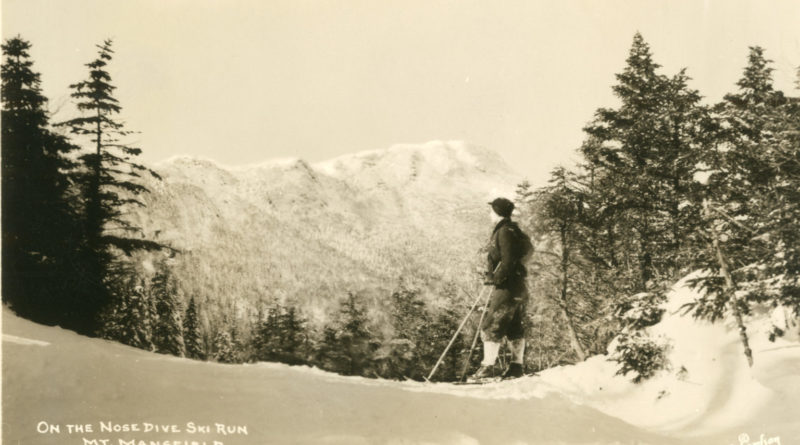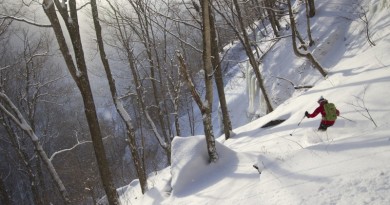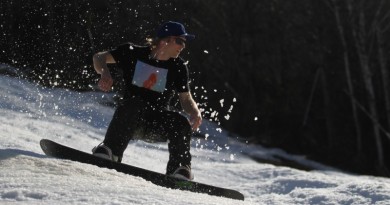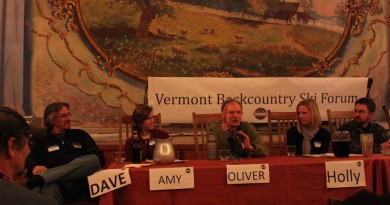How a Logger Helped Jumpstart Skiing in Vermont

By Mark Bushnell/VTDigger
Lumberman Craig Burt knew he was risking ridicule by even writing the letter. But he was convinced he was right. The year was 1935, and Burt thought he had a way for Vermont businesses to make a little more money.
“I know that to some, statements which I have made will seem visionary and unsound,” he wrote in a letter to the editor of the Bennington Banner. Burt’s peculiar idea was that the state should promote the new sport of downhill skiing.
Speaking of himself, he wrote: “(T)o one who has been interested for a decade, and has met and talked with those who have investigated Europe, it is just as sure and as good-business as any summer development we have, and much better than some.”
As co-owner of the C.E. & F.O. Burt Lumber Co. of Stowe, Burt owned a large chunk of land on Mount Mansfield. The area had been a resort for nearly 80 years when he wrote his letter. A luxurious hotel had been built just below the summit in 1858, but it catered only to the summer set. Skiing was little known in the valley well into the 20th century. The first skiers in the area may have been members of several Swedish families who moved there in 1912.
Like those Swedes, Burt viewed skiing as a form of transportation more than recreation. He bought a pair of skis and used them mostly to tour his property and make the occasional jaunt up the mountain.
But in 1921, with the town in an economic slump, Burt suggested a winter carnival that would feature skating, a toboggan run and other winter games, including ski jumping. That first festival spawned a tradition that continues today, but it did not make the town a skiing mecca. The events that would make Stowe the so-called “ski capital of the East” would occur a decade later.

In 1930, at the suggestion of a friend, Burt began opening his logging company’s Ranch Camp to skiers. Only the most diehard took Burt up on his offer, however, because the only way uphill was on foot or ski. The way down was along the unplowed Toll Road or the road into Smugglers Notch.
It was just as well that the slopes would accommodate only serious skiers, since the town’s inns and guesthouses at the time boasted only about 60 beds. Stowe had been a warm-weather tourist destination starting in the 1850s, but by the 1930s it was a fairly sleepy town again. And with the nation in the midst of the Great Depression, it hardly seemed a propitious time to launch a new industry.
But Stowe had one thing in its favor: the support of state forester Perry Merrill. In 1933, Congress created the Civilian Conservation Corps, a massive public works program that put millions to work building roads and dams, renovating old buildings and stringing phone lines. When CCC workers were dispatched to Vermont, it was up to Merrill to decide how to put them to work. At the suggestion of a Stowe Ski Club member, Merrill arranged for a squad of men to cut ski trails on Mount Mansfield.
The CCC trails created an alpine landscape unfamiliar to most skiers. Other areas — particularly Woodstock, which began operating America’s first tow rope in
1934 — presented skiers with steep, expansive fields to schuss through. But Mount Mansfield offered wilder terrain, which attracted more experienced skiers.
Mount Mansfield installed its own rope tow in 1936, but skiers could ride it only partway up the mountain. If they wanted to try the more challenging terrain near the peak, they would still have to do some hiking. As a result, they could make only two or three top-to-bottom runs on a good day.
Roland Palmedo changed all that. A New York stockbroker and the president of the Amateur Ski Club of New York, Palmedo visited Stowe one winter while searching for places to take the ski club. He liked what he saw in Stowe, but he also wanted to find a better way for skiers to get to the top.
Palmedo rallied a group of investors, including some of his friends from Wall Street and famed outdoorsman Lowell Thomas, to fund construction of a chairlift to a spot near the summit. This group organized the Mount Mansfield Lift Co. and struck a deal with Merrill to lease a 100-foot-wide and 6,500-foot-long strip of state forestland for 10 years after which the deal could be renewed. The agreement called upon the company to pay the state $1 plus 10 percent of annual revenues exceeding $40,000.
The lift, which opened in 1940, cost the company $100,000, a staggering amount in those days. Skiers paid about $1 per ride, and the company took in only $3,840 in gross revenues that first season. But word got out and revenues for 1941 soared to more than $31,000, despite the fact that the country had just entered World War II.
When the war ended, Stowe was ready to boom. During the winter of 1946-47, more than 105,000 skiers rode the resort’s lifts. The town grew to meet the ballooning demand. By 1951, the developers had built enough inns, hotels and motels in Stowe to accommodate 14,000 skiers a night.
By then, those skiers, and the money they brought into the state, were a major revenue source for Vermont’s economy, and nobody thought Craig Burt had been anything but right.




